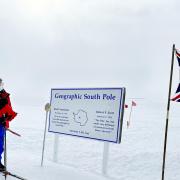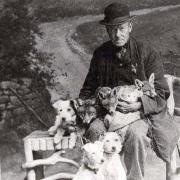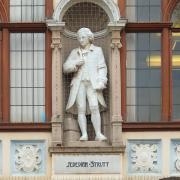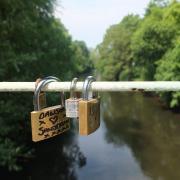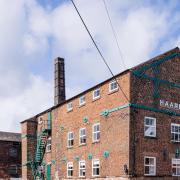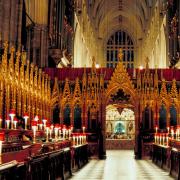The day the sleepy villages of New Mills and Hayfield faced up to a terrifying and unexpected foe - two German bombers.

During WW2, few areas of the UK were spared from Luftwaffe bombing. The High Peak of Derbyshire was no exception - most the result of German aircrews jettisoning unused bombs as they fled home. But on the Friday evening of 3rd July 1942, a daring raid wreaked havoc on two innocent High Peak villages which had, to that point, been spared the terrors of war.
Two Junkers Ju88 high speed bombers had set off low-level from their base in Brittany to bomb a propeller factory at Lostock, near Bolton. Their route had taken them across the English Channel up the Irish Sea past Anglesey before turning inland over the Ribble Estuary.
Cloud cover was lower than expected and they couldn’t find the large propeller factory (still there today and part of BAE Systems). With low fuel reserves they had no time to search so set off back to their landing destination in Amsterdam.
As with most German bombing raids in the north-west of England the shortest route was across Derbyshire and Lincolnshire to the safety of the North Sea. So it was for these two, still fully-laden, bombers. They were spotted over Trafford Park and Burnage in Manchester, and very low over Hillgate in Stockport. For an unknown reason as they approached New Mills they banked round to the north east.

At 8pm, the two aircraft came screaming up the River Goyt, machine-guns blazing. There was no air-raid warning. One flew over New Mills centre, dropping two high explosive bombs in Torr Vale, the other took a wider arc and dropped two bombs near to Swizzels sweet factory.
Although there was considerable damage there were only minor injuries. The planes sped up Sett Valley, continuing to fire machine-guns as they flew over New Mills cricket ground where a cup match was in progress between New Mills and Hayfield schools. The sports master shouted to ‘hit the deck’, luckily nobody was injured.
As the terrified children ran for home the planes dropped more bombs in the Low Leighton area of New Mills. An old Victorian workhouse, in use as an infirmary, was narrowly missed but two stone cottages, known as Whitfield Villas, and a small Wesleyan chapel, were destroyed.
The family of one of the cottages were out for a meal, but in the other was 79-year-old Mrs. Gillies, her 18-year-old grandson Maurice Handford and ten-year-old granddaughter Joan Handford, who had stayed home to practise piano.

Rescue services were quickly on site. Mrs. Gillies and Maurice were trapped beneath rubble and seriously injured, sadly Joan had been killed. Adjacent to the cottages, sat in his allotment behind the Wesleyan Chapel reading a book, caretaker Daniel McKellar was also injured after being hit by bullets and debris. After first aid he was rushed to Woods Hospital in Glossop but died the following day. In New Mills there were reports of ten others injured and 150 reports of damage to property.
The planes continued up Sett Valley to Hayfield, firing their machine-guns. As they flew over the recreational ground they released more bombs. Three stone cottages on Spring Vale Road were obliterated. Reports tell of a lack of panic and hysteria. The Home Guard, special police and the civil defence services were soon on site.
Sadly, there were six fatalities: Albert and Edith Gibson, their two daughters Gladys and Margaret, together with Hannah Robinson, and Freda Thorpe, a ten-year-old evacuee from Manchester. Freda’s two brothers and grandmother survived.
Leaving Hayfield devastated, the planes climbed over Kinder Scout, veered to the south-east and re-established their heading towards Holland. As they passed Stoney Middleton, they dropped the last of their bombs at Darlton Quarry before strafing Chatsworth House as they made good their escape.
There were no casualties at the quarry, but a crusher shed and a blacksmith’s shop was damaged. At Chatsworth House the roof, north and west side of the house were hit by machine-gun bullets, some of which just missed rare paintings in the library. The house at that time was used for 250 girls evacuated from a private school in Penrhos, North Wales. Fortunately, the girls were in the main hall for prayers and there were no casualties.
By the time the planes had left the Chatsworth area Central Group Fighter Command had been notified that two Ju 88s were flying at zero feet, forty miles west of Lincoln, heading in an easterly direction. The sector controller immediately scrambled four interceptors from the RAF base at Kirton in Lindsey, 20 miles north of Lincoln. Based there were Spitfires of 303 Polish Squadron. Arguably the most famous fighter squadron of all time, they had scored the highest number of ‘kills’ in the Battle of Britain two years previously. Their commander was Squadron Leader Jan Zumbach, an enigmatic, highly decorated and famous Battle of Britain pilot.
Flight Sergeants Wünsche and Popek were airborne first, joined at about 8:10pm by Pilot Officer Ko?ecki and Sergeant Rokitnicki. Cloud cover was still very low, but they soon spotted the two German aeroplanes two miles east of Lincoln flying at zero feet heading east in close formation.
Wünsche attacked first causing the German aircraft to separate. One broke to the north chased by Wünsche and Popek firing their machine-guns and canons. It was soon ablaze and crashed, killing all four crew members.
Popek then joined Ko?ecki and Rokitnicki in attacking the second Junker, setting its starboard engine on fire and causing it to crash-land in a corn field. The crew surrendered and were arrested by the local Home Guard. It was significantly the 178th enemy aircraft attributed to 303 Squadron from which they collected several artefacts including Iron Crosses, machine-guns and a piece of the tail fin, which they later adorned with details of the event and used it in many WW2 publicity photos.
It’s a mystery why the two Ju 88s took a dog leg that took them over New Mills and Hayfield. Perhaps the cloud cover was too low along their planned exit route and the Sett Valley offered an easier route. The villages were the last clusters of buildings they came across before reaching high moorland and were a chance to dispose of their bombs, wreak some damage, and lighten their load to be more manoeuvrable for the dog-fights they knew would inevitably come.
At Low Leighton the two cottages of Whitfield Villas were rebuilt in their original design, but the chapel was never replaced. A fire station now occupies the position of the chapel and a plaque commemorates the events in New Mills. Joan Handford and Daniel McKellar are buried at St. Georges Church next to the cricket ground and are commemorated with their names on the War Memorial in the church grounds.
In Hayfield, the cottages on Spring Vale Road were never replaced and no plaque has ever been erected. In fact, there are no sign of the carnage and destruction. As at New Mills, the names of those killed are commemorated on the War Memorial in the centre of Hayfield village with the simple inscription ‘The following civilians were killed by enemy action – Their name liveth for evermore’.
It is interesting that some of the famous photos of 303 Squadron, the most celebrated WW2 Battle of Britain Fighter squadron, involve a link to the High Peak in Derbyshire. The photos depict their most significant trophy – not a relic from the Battle of Britain, but the fin section from their 178th kill, a Ju88 bomber that had bombed the rural Derbyshire towns of New Mills and Hayfield.
Amazingly, this trophy still exists, in its original condition, and is displayed with pride and honour at the Polish Institute and Sikorski Museum in London, where I was pleased to donate a copy of my book recording the event.
Many residents of New Mills and Hayfield still remember the events of that night, and I was delighted to speak to some at a presentation I gave at New Mills Town Hall before the lockdown. I was especially honoured to meet players of both cricket teams, a resident of Whitfield Villas, and a member of the Home Guard who was on duty that fateful evening.
To conclude the cricket match story: it was replayed the following week with a victory going to New Mills. u
Frank’s book, The Bombing of New Mills and Hayfield, gives further details of the bombing of New Mills and Hayfield.








